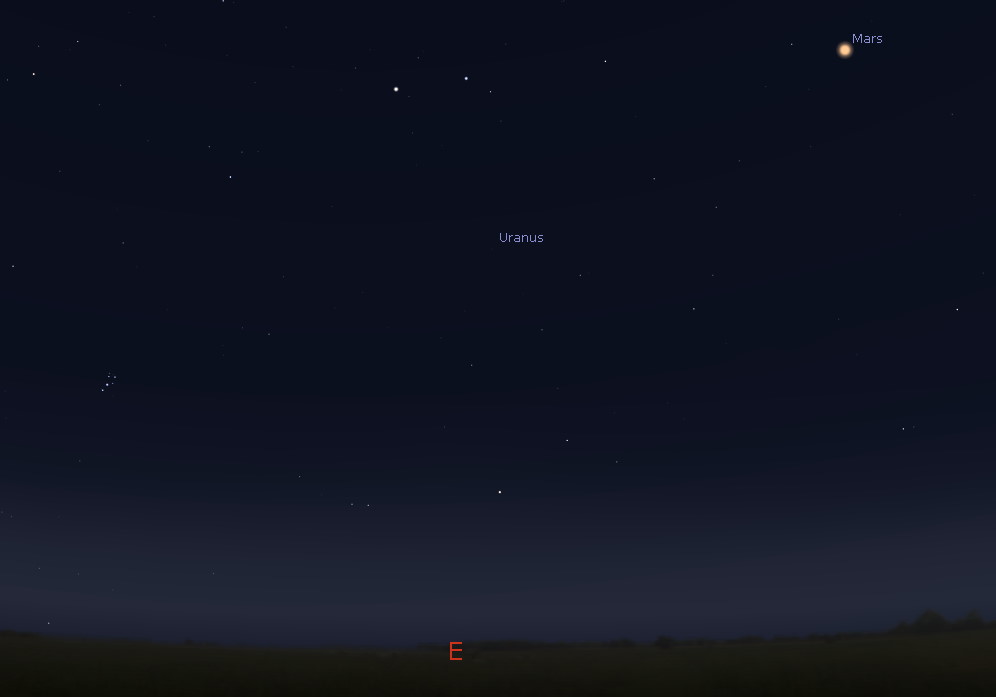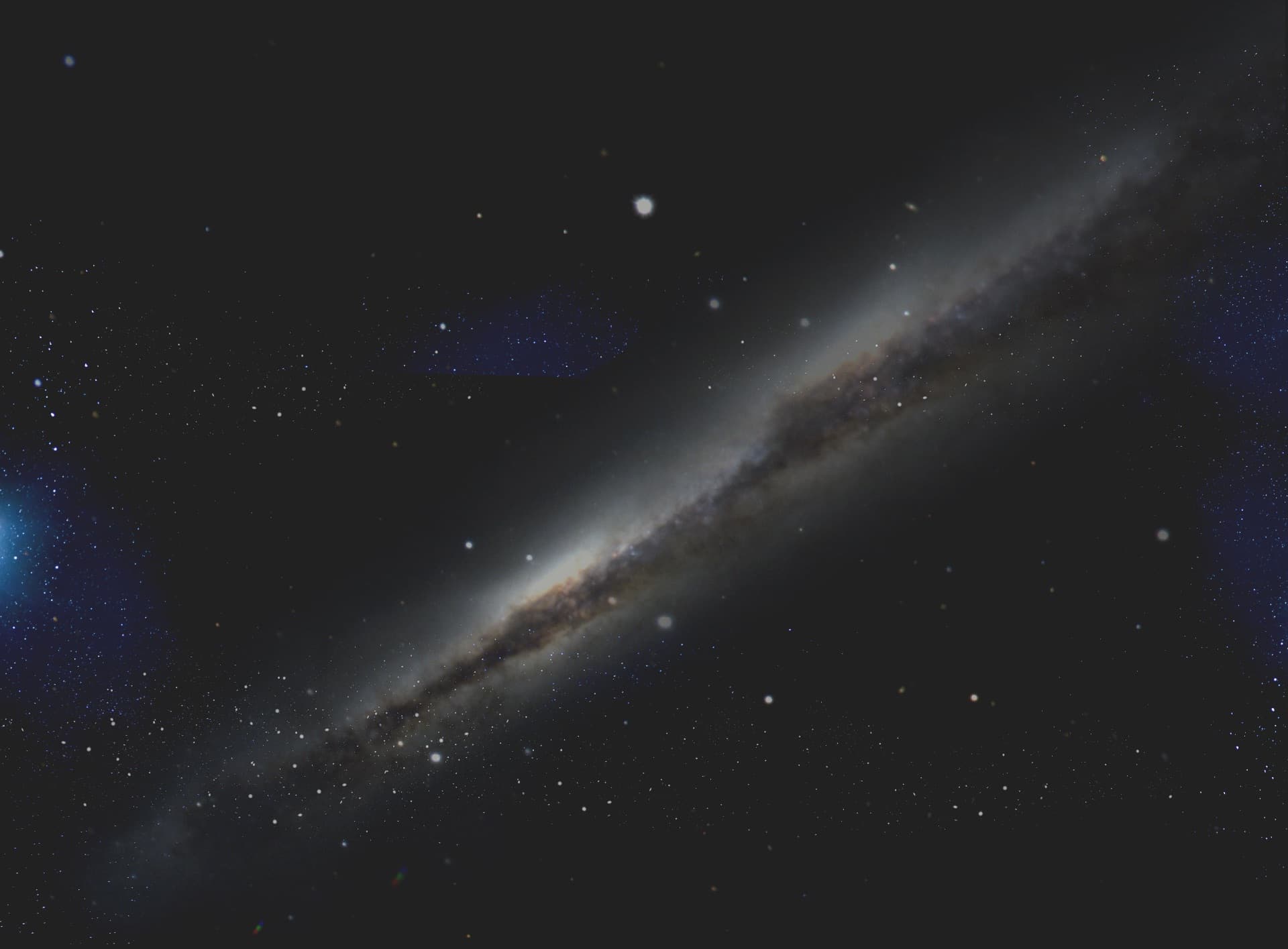
Mercury appears with Venus in the eastern predawn sky all week; both planets appear a bit closer to the horizon each morning – by next week, Mercury will be much closer to the horizon.
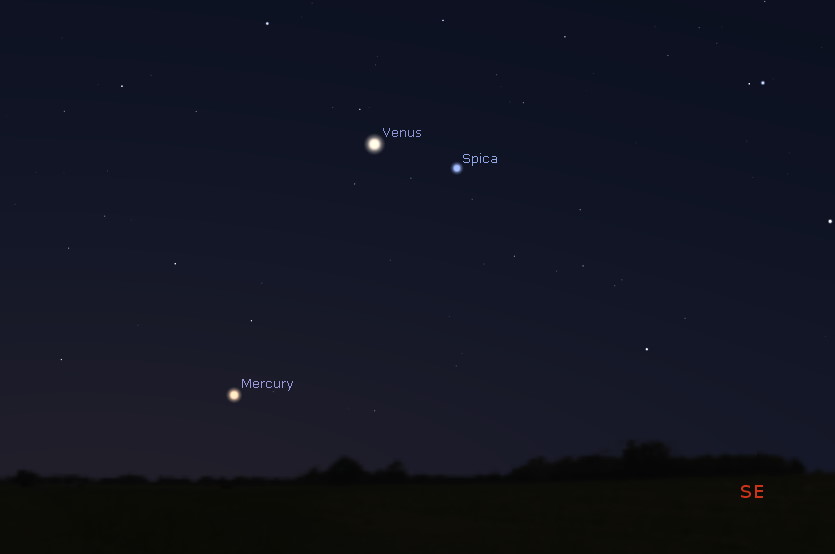 Conjunction of Mercury, Venus and the star Spica in the eastern predawn sky, Credit: Bob Trembley / Stellarium.
Conjunction of Mercury, Venus and the star Spica in the eastern predawn sky, Credit: Bob Trembley / Stellarium.Mars and Uranus continue to appear high in the eastern sky after sunset.
If you have a large enough ‘scope, you can see Uranus:
Jupiter and Saturn continue to appear in the south-southwestern sky at dusk, and setting in the southwest a few hours after sunset; from Nov 17-20, the waxing crescent Moon joins the pair of planets.
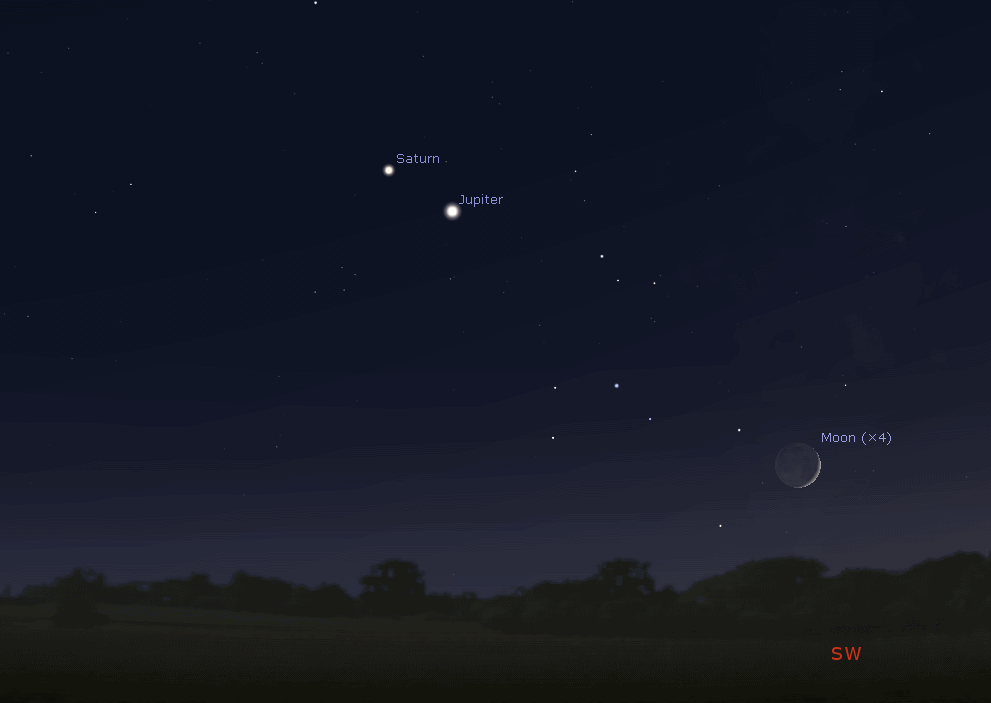 A waxing crescent Moon joins Saturn and Jupiter in the southwestern sky at dusk from Nov. 17-20. Credit: Bob Trembley / Stellarium.
A waxing crescent Moon joins Saturn and Jupiter in the southwestern sky at dusk from Nov. 17-20. Credit: Bob Trembley / Stellarium.My wife told me that she had her astronomy students look for the constellation Cassiopeia – here it is after sunset, and before sunrise.

The Moon is a waxing crescent, visible toward the southwest in early evening.
The first quarter Moon occurs on Nov. 22nd. – it will be visible high in the southern sky in early evening.
After Nov. 22nd the Moon will be a waxing gibbous – visible to the southeast in early evening, and up for most of the night.
 The Moon from 2020-11-17 – 2020-11-23. Visualizations by Ernie Wright / NASA’s Scientific Visualization Studio.
The Moon from 2020-11-17 – 2020-11-23. Visualizations by Ernie Wright / NASA’s Scientific Visualization Studio.If you click on the Moon image above, or click this link, you will go to NASA’s Moon Phase and Libration, 2020 page – it will show you what the Moon looks like right now. If you click the image on that page, you will download a high-rez TIF image annotated with the names of prominent features – helpful for logging your observations!
 Annotated close-up of a section of the Moon on Nov. 23rd. – showing the play of shadows along the terminator. Visualizations by Ernie Wright / NASA’s Scientific Visualization Studio.
Annotated close-up of a section of the Moon on Nov. 23rd. – showing the play of shadows along the terminator. Visualizations by Ernie Wright / NASA’s Scientific Visualization Studio.Moon News

The Sun has has new sunspot is emerging on it’s limb – you can see it in the lower left of the animation below. There are several regions of coronal activity in the Sun’s southern hemisphere; the northern coronal hole, apparently unsatisfied with being small for more then a week, has returned to being GINORMOUS! The southern coronal hole is small, and there are a couple small holes peppering the northern hemisphere.
The Sun seen in 193 angstroms (extreme ultraviolet) November 16, 2020:
Moderate prominence activity over the last couple days; one prominence in the lower left rises far above the Sun’s limb.
The Sun seen in 304 angstroms (extreme ultraviolet) November 16, 2020:
You can view the Sun in near real-time, in multiple frequencies here: SDO-The Sun Now.
You can create your own time-lapse movies of the Sun here: AIA/HMI Browse Data.
You can browse all the SDO images of the Sun from 2010 to the present here: Browse SDO archive.
Solar Activity on Facebook – Run by Volunteer NASA/JPL Solar System Ambassador Pamela Shivak
 The SOLARACTIVITY PICTURE OF THE DAY for Tuesday, November 17th, 2020 goes out to Gabriel Corban for this great limb shot of NOAA AR 2781.
The SOLARACTIVITY PICTURE OF THE DAY for Tuesday, November 17th, 2020 goes out to Gabriel Corban for this great limb shot of NOAA AR 2781.Solar Corona
Solar wind speed is 304.7 km/sec (↓), with a density of 3.6 protons/cm3 (↓) at 1425 UT.
Near real-time animation of the corona and solar wind from the Solar & Heliospheric Observatory (SOHO):
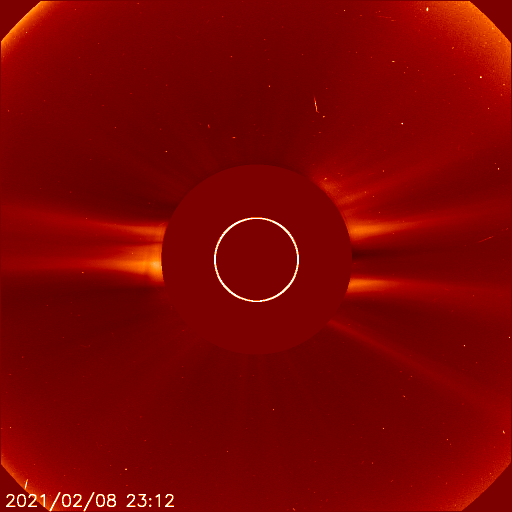 Animated LASCO C2 Coronograph showing the solar corona above the Sun’s limb (the white circle). Credit: NASA/JPL-Caltech-SOHO
Animated LASCO C2 Coronograph showing the solar corona above the Sun’s limb (the white circle). Credit: NASA/JPL-Caltech-SOHOSun News
https://twitter.com/universal_sci/status/1327353598439731200

Potentially hazardous asteroids: 2037 (last updated June 2, 2020)
Total Minor Planets discovered (NASA): 1,026,969 (-591)
Total Minor Planets discovered (MPC): 993,960
Upcoming Earth-asteroid encounters:
| Asteroid |
Date(UT)
|
Miss Distance
|
Velocity (km/s)
|
Diameter (m)
|
| 2020 VS4 |
2020-Nov-17
|
4.3 LD
|
8.3
|
15
|
| 2020 VG4 |
2020-Nov-17
|
2.1 LD
|
8
|
7
|
| 2020 VY |
2020-Nov-17
|
16.2 LD
|
11.6
|
36
|
| 2020 VU5 |
2020-Nov-18
|
6.4 LD
|
4.8
|
12
|
| 2020 VQ2 |
2020-Nov-18
|
4 LD
|
10.8
|
15
|
| 2020 VX4 |
2020-Nov-18
|
1.1 LD
|
11.4
|
12
|
| 2020 VK4 |
2020-Nov-19
|
5.1 LD
|
3.2
|
8
|
| 2020 VP4 |
2020-Nov-19
|
2.8 LD
|
3.6
|
10
|
| 2020 VA1 |
2020-Nov-20
|
11.7 LD
|
8.7
|
38
|
| 2020 VR2 |
2020-Nov-21
|
6 LD
|
6.6
|
13
|
| 2020 VW2 |
2020-Nov-23
|
18.5 LD
|
6.8
|
13
|
| 2017 WJ16 |
2020-Nov-23
|
5 LD
|
4.8
|
49
|
| 2020 TJ8 |
2020-Nov-24
|
16.8 LD
|
4.6
|
33
|
| 2018 RQ4 |
2020-Nov-26
|
8.1 LD
|
7.4
|
15
|
| 2020 VO2 |
2020-Nov-26
|
12.6 LD
|
6.2
|
17
|
| 2020 KZ2 |
2020-Nov-28
|
5.7 LD
|
3.9
|
10
|
| 2020 VF6 |
2020-Nov-28
|
8.4 LD
|
17.8
|
36
|
| 153201 |
2020-Nov-29
|
11.2 LD
|
25.1
|
490
|
| 2020 VT5 |
2020-Nov-30
|
17.7 LD
|
16.3
|
40
|
| 2020 SO |
2020-Dec-01
|
0.1 LD
|
3.9
|
6
|
| 2020 VQ5 |
2020-Dec-01
|
19.9 LD
|
12.1
|
39
|
| 2019 XH2 |
2020-Dec-02
|
16.1 LD
|
6.4
|
6
|
| 2018 PK21 |
2020-Dec-08
|
12.2 LD
|
3.1
|
23
|
| 2019 XQ1 |
2020-Dec-13
|
18.4 LD
|
8.6
|
30
|
| 2020 VY1 |
2020-Dec-16
|
13.3 LD
|
4.4
|
22
|
| 2017 XQ60 |
2020-Dec-21
|
10.8 LD
|
15.6
|
47
|
| 2011 CL50 |
2020-Dec-24
|
3.1 LD
|
3.4
|
11
|
| 501647 |
2020-Dec-25
|
7.9 LD
|
10
|
123
|
| 2012 XE133 |
2020-Dec-27
|
11.7 LD
|
9.2
|
74
|
| 2016 AF2 |
2020-Dec-27
|
7.3 LD
|
5.3
|
9
|
| 2012 UK171 |
2020-Dec-30
|
15.5 LD
|
4.7
|
47
|
| 2019 YB4 |
2021-Jan-02
|
16.8 LD
|
7.2
|
16
|
| 2003 AF23 |
2021-Jan-03
|
18.3 LD
|
15.8
|
235
|
| 2019 QW2 |
2021-Jan-03
|
8.8 LD
|
4.9
|
39
|
| 2012 BT1 |
2021-Jan-04
|
13.6 LD
|
7.7
|
12
|
| 2016 CO247 |
2021-Jan-06
|
19.3 LD
|
16.7
|
282
|
| 2018 KP1 |
2021-Jan-06
|
8.2 LD
|
4.4
|
34
|
| 332446 |
2021-Jan-06
|
9.6 LD
|
11
|
408
|
| 2015 NU13 |
2021-Jan-09
|
14.8 LD
|
15.1
|
408
|
| 2020 RO6 |
2021-Jan-11
|
19.5 LD
|
7.9
|
105
|
| 2013 YS2 |
2021-Jan-11
|
18.2 LD
|
3.7
|
78
|
Notes: LD means “Lunar Distance.” 1 LD = 384,401 km, the distance between Earth and the Moon. Red highlighted entries are asteroids that either pass very close, or very large with high relative velocities to the Earth. Table from SpaceWeather.com
 On November 16, 2020, the NASA All Sky Fireball Network reported 50 fireballs.
On November 16, 2020, the NASA All Sky Fireball Network reported 50 fireballs.
(23 sporadics, 15 Leonids, 1 Northern Taurid, 1 Nov. omega Orionid)
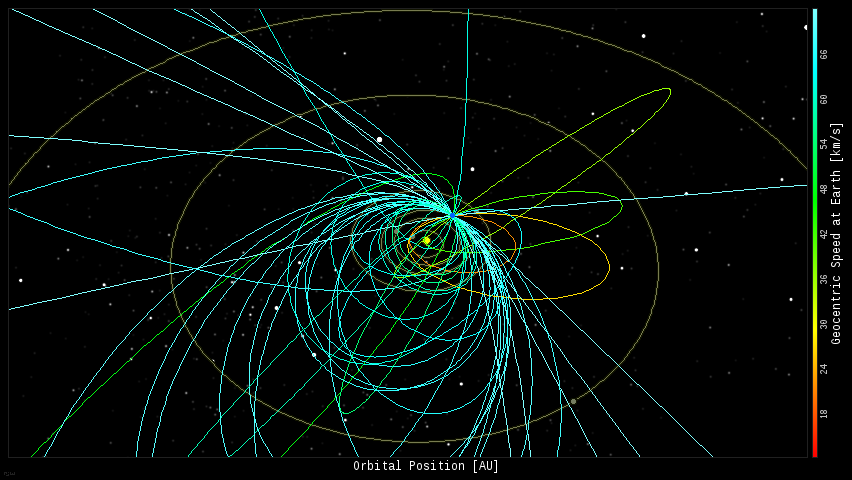 In this diagram of the inner solar system, all of the fireball orbits intersect at a single point–Earth. The orbits are color-coded by velocity, from slow (red) to fast (blue). Credit: SpaceWeather.com
In this diagram of the inner solar system, all of the fireball orbits intersect at a single point–Earth. The orbits are color-coded by velocity, from slow (red) to fast (blue). Credit: SpaceWeather.comFireball News
If you see a bright meteor or a fireball, please REPORT IT to the American Meteor Society!
 Position of the planets and several spacecraft in the inner solar system:
Position of the planets and several spacecraft in the inner solar system:
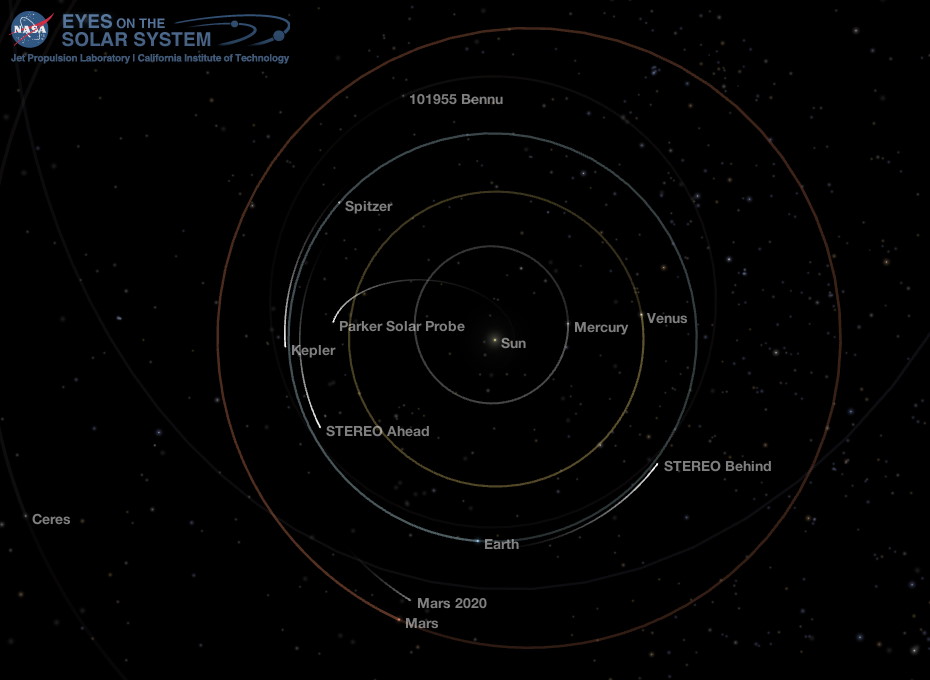 Position of the planets and a couple spacecraft in the inner solar system, 2020-11-17. Credit: Bob Trembley / NASA Eyes on the Solar System.
Position of the planets and a couple spacecraft in the inner solar system, 2020-11-17. Credit: Bob Trembley / NASA Eyes on the Solar System.Position of the planets in the middle solar system:
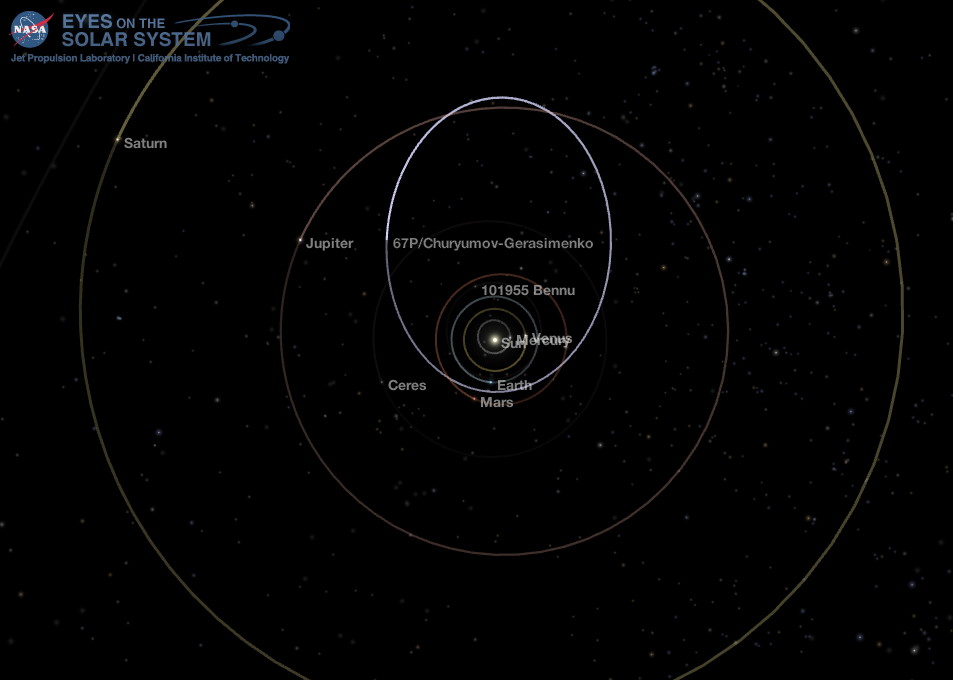 Position of the planets in the middle solar system, 2020-11-17. Credit: Bob Trembley / NASA Eyes on the Solar System.
Position of the planets in the middle solar system, 2020-11-17. Credit: Bob Trembley / NASA Eyes on the Solar System.Position of the planets, some dwarf planets and some transneptunian objects in the outer solar system.
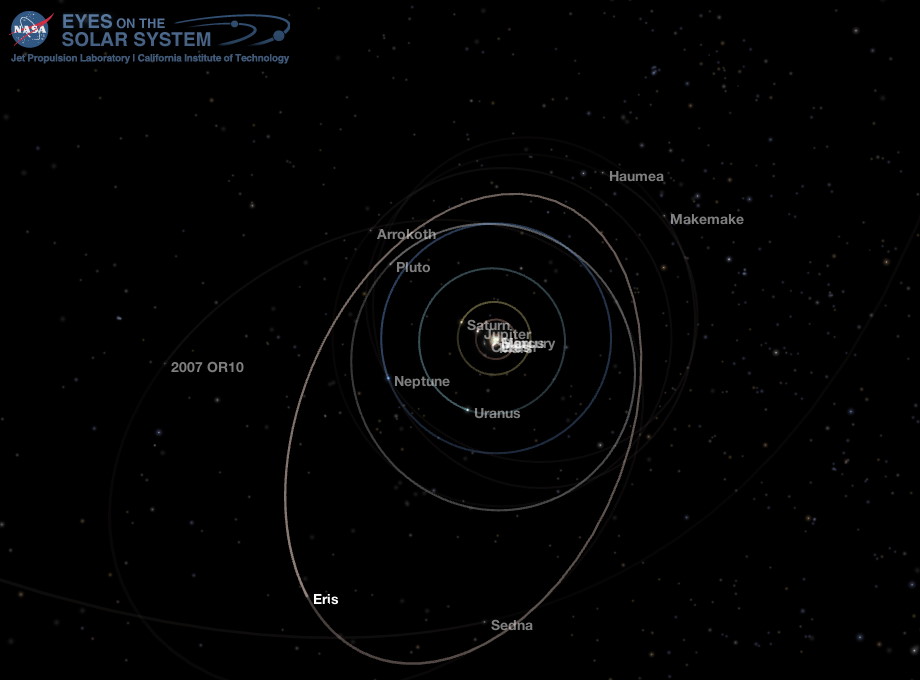 Position of the planets and some transneptunian objects in the outer solar system, 2020-11-17. Credit: Bob Trembley / NASA Eyes on the Solar System.
Position of the planets and some transneptunian objects in the outer solar system, 2020-11-17. Credit: Bob Trembley / NASA Eyes on the Solar System.Solar System News

OSIRIS-REx Asteroid Sample Return Mission
International Space Station: #SpaceStation20th
HiRISE – on the Mars Reconnaissance Orbiter:
Hubble Space Telescope:
Climate:
See a list of current NASA missions here: https://www.jpl.nasa.gov/missions/?type=current

ex·o·plan·et /ˈeksōˌplanət/, noun: a planet orbiting a star other than the Sun.
Data from the NASA Exoplanet Archive
* Confirmed Planets Discovered by TESS refers to the number planets that have been published in the refereed astronomical literature.
* TESS Project Candidates refers to the total number of transit-like events that appear to be astrophysical in origin, including false positives as identified by the TESS Project.
* TESS Project Candidates Yet To Be Confirmed refers to the number of TESS Project Candidates that have not yet been dispositioned as a Confirmed Planet or False Positive.
Exoplanet News

Hubble: Beautiful Universe
Tour of the Local Stellar Neighborhood
Continuing with my visual tour of nearby stars and their systems, we travel to Gliese 3618 (LHS 288, Luyten 143-23) , about 15.8 light years distant.
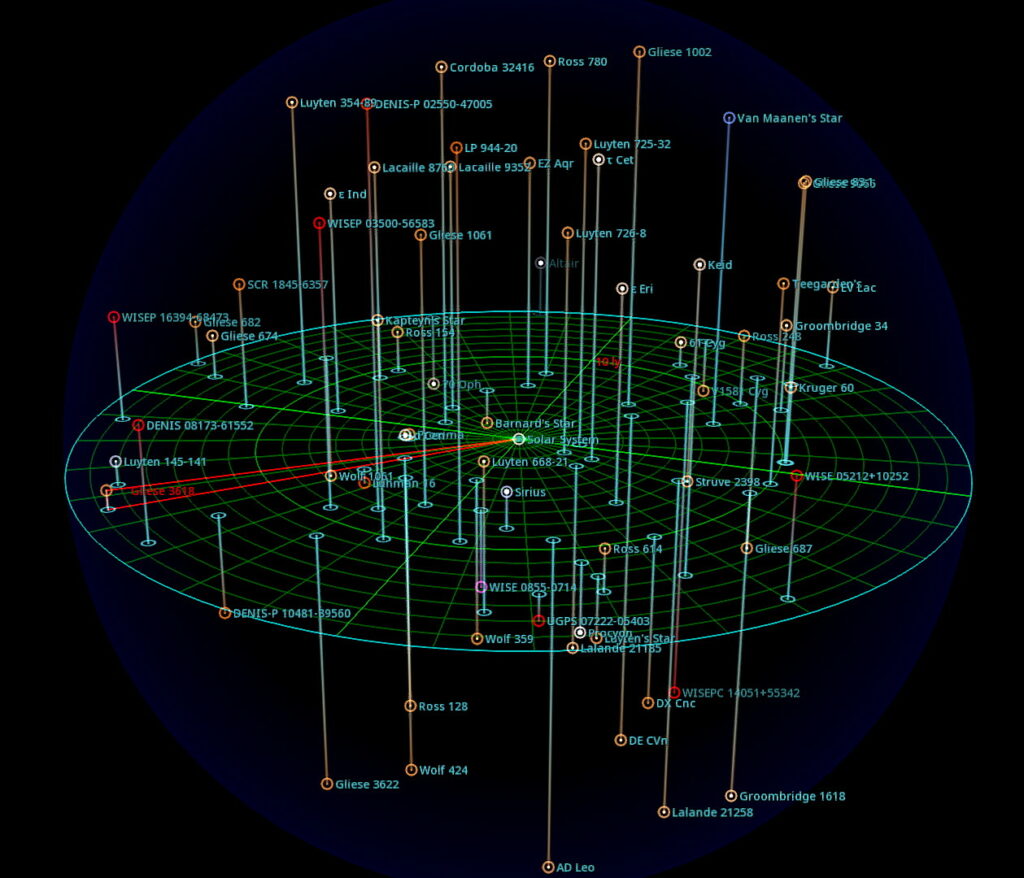 Gliese 3618 is about 15.8 light years from Sol; the plane (green) is aligned with the orientation of the plane of the Milky Way galaxy. Credit: SpaceEngine / Bob Trembley.
Gliese 3618 is about 15.8 light years from Sol; the plane (green) is aligned with the orientation of the plane of the Milky Way galaxy. Credit: SpaceEngine / Bob Trembley.
Gliese 3622 (LHS 292)
LHS 288 (Luyten 143-23) is a red dwarf around 15.8 light years from the Sun, the closest in the constellation Carina (near Eta Carinae). It is far too faint to be seen with the unaided eye, with an apparent magnitude of 13.92.
Recent studies suggest it may harbour a planet with a mass as small as 2.4 Jupiter, but the possibility that it passed over an undetected faint star could not be eliminated. – Wikipedia
Artist Rendering of the Gas Giant Exoplanet Orbiting Gliese 3618
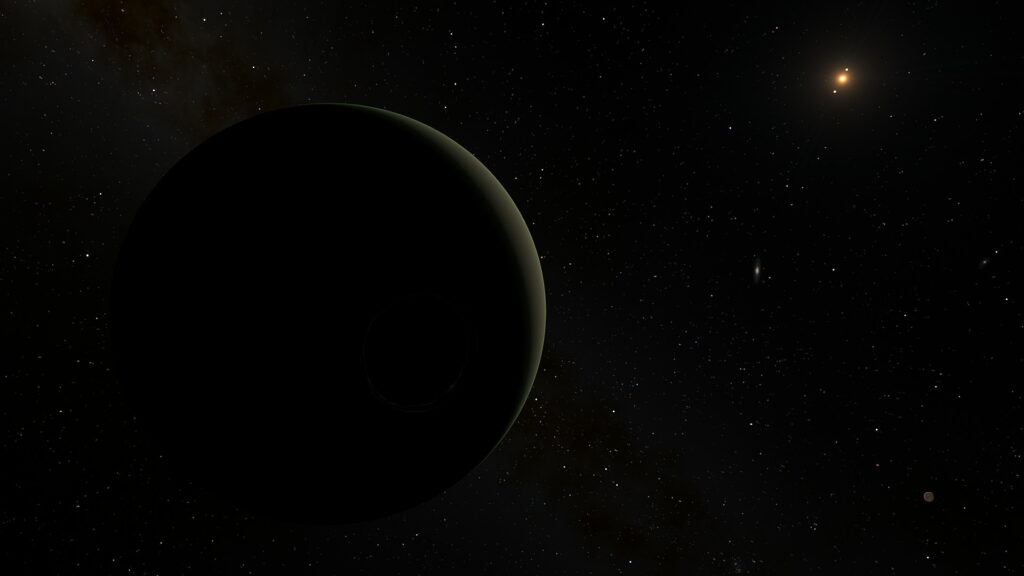 Artistic rendering of an exoplanet orbiting the red dwarf star Gliese 3618. Credit: Bob Trembley / SpaceEngine.
Artistic rendering of an exoplanet orbiting the red dwarf star Gliese 3618. Credit: Bob Trembley / SpaceEngine.Artist Rendering of a Hypothetical Moon Orbiting Gliese 3618’s Gas Giant
This system has a large exoplanet, massing more than Jupiter – it’s very likely that this exoplanet will have several moons; the Wikipedia article above indicates a single exoplanet in this system – SpaceEngine, however, has multiple exoplanets with their own moons. I wanted to see of the catalogs that SpaceEngine uses have been updated, and that led me down a path of discovery I was not expecting; I did a starch on “star catalogs” and I was amazed at how many there have been! I see a bit of research in my future.
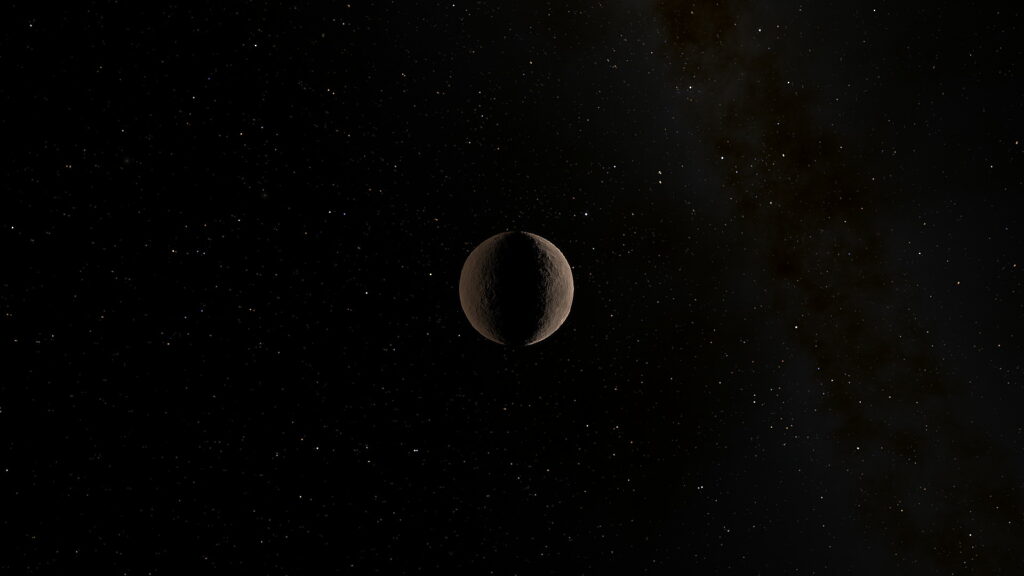 Artistic rendering of an exomoon orbiting the gas giant in the Gliese 3618 system – the moon is illuminated by the gas giant (left) and red dwarf star (right). Credit: Bob Trembley / SpaceEngine.
Artistic rendering of an exomoon orbiting the gas giant in the Gliese 3618 system – the moon is illuminated by the gas giant (left) and red dwarf star (right). Credit: Bob Trembley / SpaceEngine.
What I was listening to when I was editing this:
Stay safe, be well, and look up!
Apps used for this post:
NASA Eyes on the Solar System: an immersive 3D solar system and space mission simulator – free for the PC /MAC. I maintain the unofficial NASA Eyes Facebook page.
Universe Sandbox: a space simulator that merges real-time gravity, climate, collision, and material interactions to reveal the beauty of our universe and the fragility of our planet. Includes VR support.
SpaceEngine: a free 3D Universe Simulator for Windows. Steam version with VR support available.
Stellarium: a free open source planetarium app for PC/MAC/Linux. It’s a great tool for planning observing sessions. A web-based version of Stellarium is also available.
Section header image credits:
The Sky – Stellarium / Bob Trembley
Observing Target – Turn Left at Orion / M. Skirvin
The Moon – NASA/JPL-Caltech
The Sun – NASA/JPL-Caltech
Asteroids – NASA/JPL-Caltech
Fireballs – Credited to YouTube
Comets – Comet P/Halley, March 8, 1986, W. Liller
The Solar System – NASA Eyes on the Solar System / Bob Trembley
Spacecraft News – NASA Eyes on the Solar System / Bob Trembley
Exoplanets – Space Engine / Bob Trembley
Light Pollution – NASA’s Black Marble
The Universe – Universe Today
